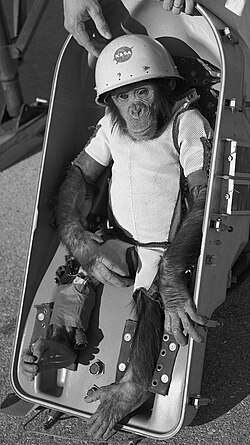Albert II (monkey)

Albert II was a male rhesus macaque monkey who was the first primate and first mammal to travel to outer space.[1] He flew from Holloman Air Force Base in New Mexico, United States, to an altitude of 83 miles (134 km) aboard a U.S. V-2 sounding rocket on June 14, 1949. Albert died upon landing after a parachute failure caused his capsule to strike the ground at high speed.[2][3] Albert's respiratory and cardiological data were recorded up to the moment of impact.[4]
Albert II's flight, run by the Alamogordo Guided Missile Test Base and organized with the help of Holloman Air Force Base, followed the likely preflight death of Albert I before a 39 mi (63 km) high mesospheric flight aboard a V-2 rocket on June 18, 1948. The capsule was redesigned in-between flights to enlarge the cramped quarters experienced by Albert I.
Background
[edit]Animals were launched into space in order to test the survivability of spaceflight, before human spaceflights were attempted. Before Albert II, the only previous known living beings in space were fruit flies, launched by the United States in a V-2 rocket suborbital flight on February 20, 1947. The flies were recovered alive. Albert I was a nine-pound monkey who was anesthetized and placed inside the rocket's crew capsule in the nose of the V-2 rocket.[5] The flight did not reach outer space.
Albert's spaceflight
[edit]Albert was launched into space on June 14, 1949, aboard a V-2 rocket from White Sands, New Mexico. He was connected to equipment that successfully monitored his heartrate and other vitals. The flight reached an altitude of approximately 83 miles (134 kilometers),[6] past the Kármán line, 100km of altitude generally accepted as the boundary of space.[7] Three minutes after the launch, the space capsule disconnected from the booster, preparing for Albert's descent. Upon re-entry, the ship's parachute failed and Albert II was killed on impact.[8] His crash-landing, occurring approximately six minutes after launch, left a 10-foot crater in the ground.[9]
The flight provided useful data for scientists to prepare for human spaceflight, as though the ship's parachute had failed, the vitals data had been successfully transmitted back to ground control on Earth. David Simons, the United States Air Force project officer for V-2 animal studies stated that Albert’s heart rate was “clearly disturbed” by g-forces.[9]
Aftermath
[edit]
After Albert II, several other monkeys named Albert followed. Albert III was killed before he reached space when the V-2 rocket exploded during the ascent. Albert IV met a similar fate as Albert II - he reached space (though several miles lower than II), and died on impact with the ground due to a parachute release malfunction. Following this, NASA switched to using Aerobee rockets, and on April 18, 1951, a monkey, possibly called Albert V, died once again due to parachute failure during descent. Two months after Soviet space dogs Dezik and Tsygan survived a July 1951 spaceflight, Yorick, also called Albert VI, attained a non-space height of 72 km (44.7 mi) but did become the first primate to survive a landing. He died two hours later.
On January 31, 1961, over 12 years after Albert II's flight, Ham, a chimpanzee, became the first great ape in space. He flew a suborbital flight on the Mercury-Redstone 2 mission, part of the U.S. space program's Project Mercury.[10][11] Ham lived for 19 more years after his flight.
See also
[edit]- Animals in space
- Monkeys and apes in space
- Alice King Chatham, who designed Albert II's oxygen mask and harness
- Laika, a Russian space dog, the first animal to orbit the Earth (November 3, 1957)
- Ham, a chimpanzee, the first great ape in space (January 31, 1961)
- Yuri Gagarin, the first human in space and first primate to orbit the Earth (April 12, 1961)
- Enos, the first chimpanzee and third primate to orbit the Earth (November 29, 1961)
- List of individual monkeys
References
[edit]- ^ Bartels, Elizabeth Dohrer Contributions from Meghan; published, Elizabeth Howell (January 27, 2022). "Animals in space". Space. Retrieved September 25, 2025.
- ^ Monkeys in Space: A Brief Spaceflight History
- ^ Beischer, DE; Fregly, AR (1962). "Animals and man in space. A chronology and annotated bibliography through the year 1960". US Naval School of Aviation Medicine. ONR TR ACR-64 (AD0272581). Archived from the original on December 4, 2012. Retrieved June 14, 2011.
- ^ "The Beginnings of Research in Space Biology at the Air Force Missile Development Center, 1946–1952". History of Research in Space Biology and Biodynamics. NASA. January 1958. Retrieved June 26, 2021.
- ^ "History of Research in Space Biology and Biodynamics, - PART I - THE BEGINNINGS OF RESEARCH IN SPACE BIOLOGY AT THE AIR FORCE MISSILE DEVELOPMENT CENTER, 1946-1952". history.nasa.gov. Retrieved June 14, 2023.
- ^ Neckar, Elisa (June 14, 2025). "June 14, 1949: The first mammal in space". Astronomy Magazine. Retrieved September 25, 2025.
- ^ "100km Altitude Boundary for Astronautics | World Air Sports Federation". www.fai.org. August 1, 2017. Retrieved September 25, 2025.
- ^ "A Brief History of Animals in Space - NASA". January 18, 1998. Retrieved September 25, 2025.
- ^ a b Ferreira, Becky (June 14, 2017). "The First Primate in Space Was Drugged and Strapped into a Nazi-Designed Rocket". VICE. Retrieved September 25, 2025.
- ^ "Chimp survives 420-mile ride into space". Lewiston Morning Tribune. Idaho. Associated Press. February 1, 1961. p. 1.
- ^ "Chimp sent out on flight over Atlantic". The Bulletin. Bend, Oregon. UPI. January 31, 1961. p. 1.